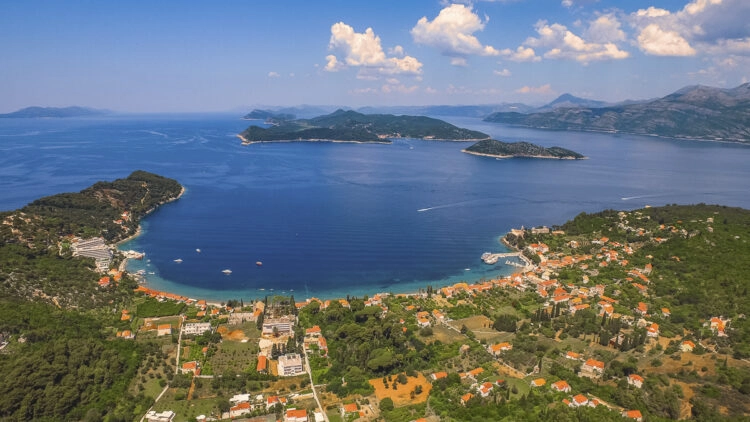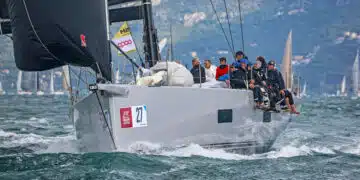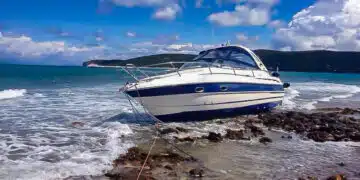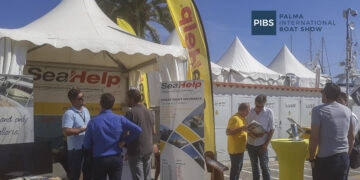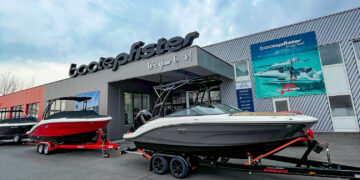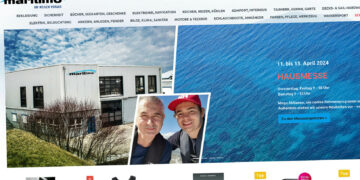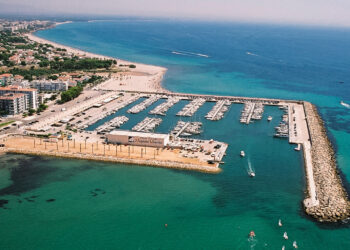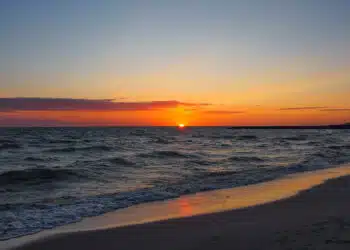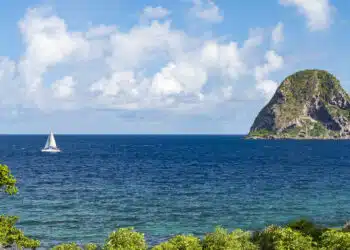Of course, if you are sailing along the southern Dalmatian coast, a visit to Dubrovnik is a must. But only a few nautical miles northwest of Dubrovnik and southeast of the Pelješac peninsula, there are the inhabited Elaphite islands of Koločep, Lopud and Šipan, three jewels that invite you to take a detour, partly with quiet bays, many sights and quaint konobas, some of which are located directly on the beach.
The Elaphites (also deer islands, from gr. elaphos “deer”), the archipelago belonging to the Dubrovnik-Neretva County off the southern Dalmatian coast, are located only a few kilometers northwest of Dubrovnik and therefore invite a side trip if the crew is planning a visit to Dubrovnik anyway or coming from there, heading northwest to Peljesac or Mljet.
Thirteen islands are counted among the Elaphites: these are Šipan, Lopud, Koločep, Jakljan, Daksa, Sveti Andrija, Ruda, Mišnjak, Kosmeč, Goleč, Crkvine and Tajan as well as Olipa. It should be noted that the island of Lokrum (Italian: Lacroma), located immediately in front of the old port of Dubrovnik, does not administratively belong to the Elaphites, but to the city of Dubrovnik.
The Elaphites are separated from the mainland by the Koločeper Channel, the waterway between Lopud and Šipan is called Lopud Passage (literally “Gate of Lopud”), the narrow, winding corridor between Šipan and Jakljan is called Harpoti. Only the three largest islands of the archipelago are inhabited and therefore shall be presented here in more detail.
Only the three largest islands of the archipelago are inhabited: Koločep, Lopud and Šipan
Koločep (Italian: Calamotta), the easternmost of the three sisters, is only 2.5 square kilometers in size, in the two settlements on the coast (Gornje Čelo and Donje Čelo) live about 150 inhabitants, but (this applies to all of the three islands) the majority of them live on the island only in the tourist season, the winter months are traditionally spent on the mainland.
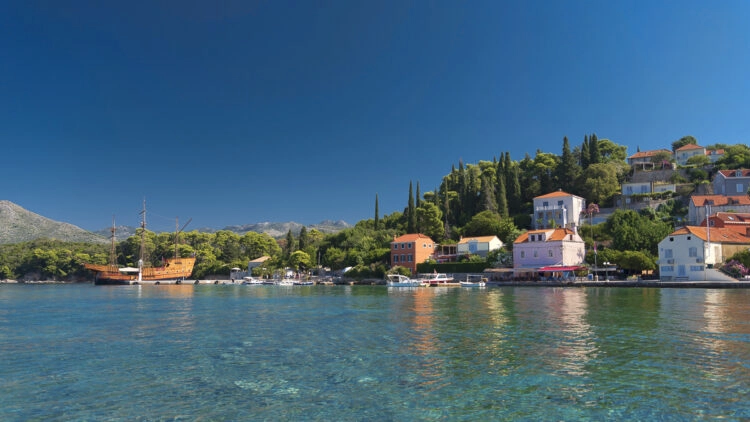
Two bays invite to an anchor stop in Koločep: in Donje Celo in the north of the island you can lie well in southern winds, the larger of the two bays is unprotected for it to the northwest. Attention: the pier on the western shore should be kept free for ferries. The konoba serves simple, relatively inexpensive food, and there is a small supermarket in town. If you want, visit the 13th-century Church of the Assumption of the Virgin Mary or walk about two kilometers to the smaller anchorage to the east, called Gornie Celo.
In Gornie Celo one lies unprotected in winds from north over east to south. Attention: the small boat harbor behind the pier is reserved for local boats, and the pier head itself must be kept clear for ferries. Worth seeing is the church of St. Anthony in the middle of the footpath between Donje Čelo and Gornje Čelo from the 14th century the remains of a defense tower above the port of Gornje Čelo.
A footpath leads past the church to the steep bank. There is an impressive staircase carved into the stone down to a bathing place in the sea. Around Koločep there are also attractive places for divers. Directly above the harbor, moreover, the small Konoba Skerac invites you from May to early October to enjoy meat and fish dishes and a beautiful view over the bay.
The island of Lopud is also called Mezzo, the Middle, in Italian
Coming from Koločep, the nearest of the inhabited Elaphite islands to the northwest is the island of Lopud (Italian Lafota or also Mezzo, the Middle). On the island of about 4.5 square kilometers there is a settlement of the same name on the northwest coast, where about 220 inhabitants live. Lopud is undoubtedly one of the most beautiful and architecturally interesting places in the whole Elaphite archipelago.
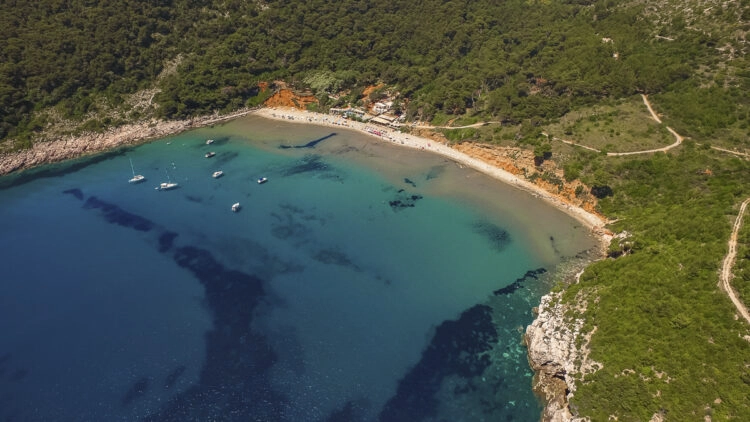
Yachts are best anchored here directly in front of the beach, because the small harbor at the foot of the Franciscan monastery of Lopud is occupied. But beware: only in good weather you can moor safely here, in stronger winds from west over north to northeast you can go to the opposite side of the island, to the bay of Sunj, where there is also a simple (beach) snack bar. However, if the wind is from the south, it is not safe to lie here, and if a thunderstorm threatens, it is advisable to find a really sheltered harbor nearby in time.
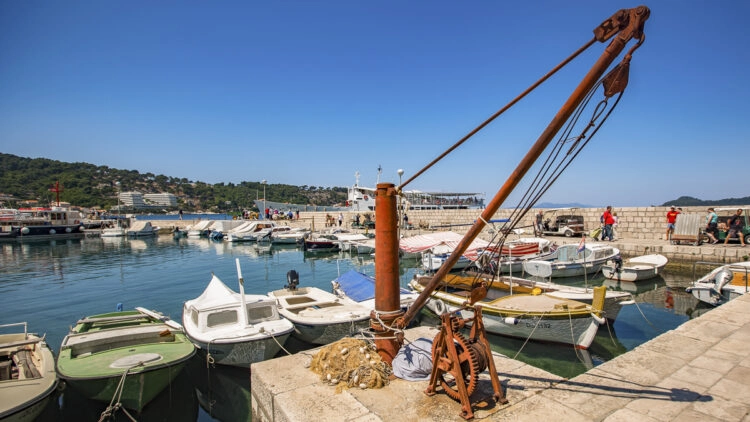
For the village of Lopud with its harbor in the bay about a kilometer long, with houses from the 15th/16th century and the Franciscan monastery with the church of St. Mary of Špilice (15th/16th century) directly at the entrance to the harbor, you should reserve at least one day (and one evening). If you wish, you can also visit the church of the Holy Trinity with the tomb of Captain Vice Buna (15th/16th century) above the cliffs in front of the harbor entrance, as well as the parish church of St. Mary of Šuni (15th century) not far from the path from the village of Lopud to the Šuni bay.
There are remains of several fortified towers and houses, as well as ruins of numerous medieval chapels and little churches inland, some dating back to the 9th/10th century, from which Sveti Ivan Krstitelj (St. John the Baptist) offers a beautiful panoramic view over the bay of Lopud. Other places of interest are the ruins of the Španjola fort above the village of Lopud, the Đorđić-Mayneri park and the lookout pavilion on the promenade path just behind the Lafodia Hotel.
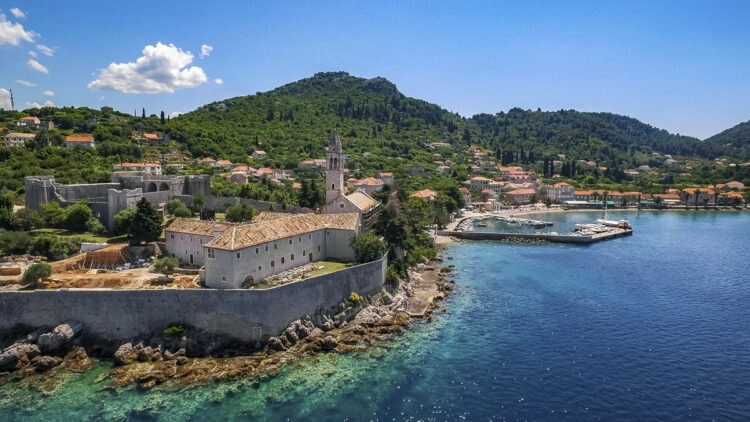
What applies to Lopud also applies to the two neighboring islands of Kolocep in the southeast and Sipan in the northwest: hiking trails can be found on all three islands, as well as swimming opportunities at several places, but the most attractive is considered to be the sandy beach of Šunj Bay on Lopud, which is easily accessible from the village after crossing the island (about 15 minutes walk). There are also several restaurants and cafes here, some of which are located directly on the beach.
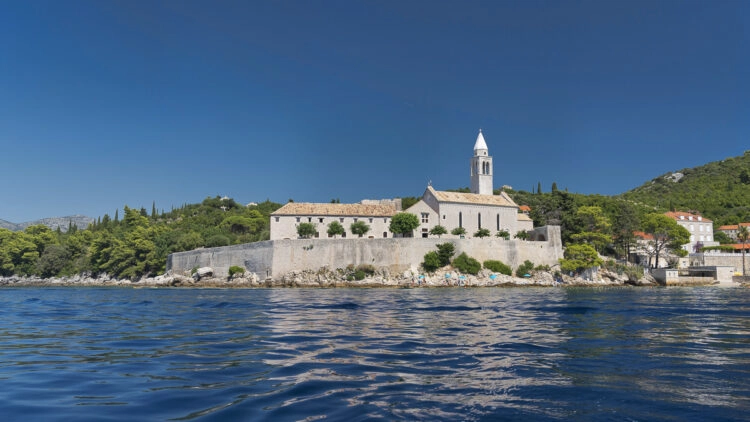
Šipan, the most northwesterly of the three inhabited elaphite islands, is also the largest
Šipan (Italian: Giuppana), the most northwestern of the three inhabited Elaphite islands, is also the largest: 16.5 square kilometers measures the island, which hosts two settlements on the coast (Suđurađ, Šipanska Luka) and four smaller settlements inland (Frajga, Sutulija, Vonjevo Selo, Ođak) with a total of about 450 inhabitants.
Šipanska Luka, in the northwest of the largest elaphite island, is the safest place to lie in a deep and largely sheltered bay; swell is only to be expected in strong winds from the northwest. Yachts should not moor at the breakwater on the eastern shore, as this is reserved for excursion boats. Just south of it, however, is the town pier, where you can moor alongside. In the west of the bay there are buoys for mooring; however, these belong to Konoba Kod Marka – worth a visit.
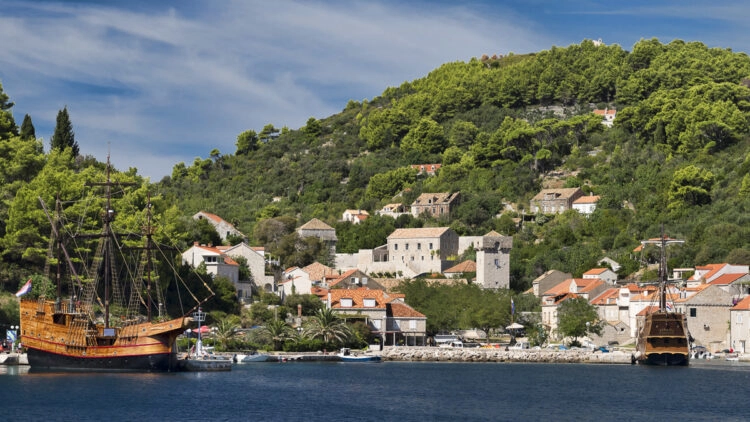
If you want, in Šipanska Luka you can visit the Sorkočević villa with fortifications and gardens, the remains of a Roman villa, the late Gothic church of St. Stephen from the 13th century, villas from the 19th century and – above the village – the remains of the so-called Rector’s Palace (15th century).
On the opposite side of Šipan, on the southeast coast, is the village of Suđurađ with buildings from the 16th century, including the Skočibuha villa with defense towers (16th century) and the Getaldić villa (16th century). Century), the fortified church of the Holy Spirit (16th century) and a ruin of the church of St. Stephen (13th century) on the outskirts of the village, as well as a small Gothic church of the Holy Trinity on the hill of the same name above Suđurađ.
However, those who are not familiar with the area should approach Suđurađ Bay only during daylight hours, as there are several unlit cliffs to the northeast of the harbor. There are two larger piers, but they must be kept clear for ferries. If you want, you can simply moor your yacht between the piers with the stern; mooring lines are available. Attention: directly at the pier it is only 1.5 meters deep.
Tip: a visit to Pakljena Bay in the northeast of the island of Sipan
In the northeast of the island, a beautiful bay with crystal clear water invites you to take a detour; its name: Pakljena. Inside the manageable bay there is a jetty, but only one yacht fits on it. In a former boat shed of a monastery, a cozy konoba has been set up here. During the day, excursion boats from Dobrovnik often come here, but they return in the late afternoon. Except for winds from the northeast, it is very quiet here.
From here, several excursions into the interior are possible: several sacral buildings, including the fortified church complex with churches of St. Mary of Mercy and St. Michael, a rectory and a fortified tower in Pakljena (16th century), the remains of the church of St. Michael on Mount Big (possibly 7th century), as well as the remains of a (probably) Illyrian burial mound on Mount Sutulija invite you to extensive hikes and explorations.
The first written mention of the Elaphite archipelago can be found in Pliny the Elder’s Naturalis Historia (c. 23-79), where it is mentioned under the name still in use today. Why the name Elaphites, however, is derived from the Greek “elaphos”: “deer”, has not been clearly clarified until today.
On the one hand it is claimed that there might have been deer on the islands in former times (which is considered very doubtful). Others interpreted the shape of the archipelago as that of a stag. Another derivation of the name refers to Hellas (Greek: Greece) and “Phytos” (Greek: plant), meaning “islands of the Greek plant”, which could mean olive trees.
Elaphites: Settlement traces from Illyrian, Greek and Roman times
However, it is a fact that on the islands there are traces of settlements from Illyrian, Greek and Roman times. It is possible that there was even a battle between the followers of Caesar and Pompey here in 47 BC at Šipan. After the dissolution of the Republic of Ragusa by Napoleon in 1808, the Elaphites were annexed to the Illyrian Provinces under French control the following year, and from the Congress of Vienna in 1815 until the end of the First World War they belonged to the Crown Land of Dalmatia of the Austro-Hungarian Monarchy.
From 1918 to 1941 the Elaphites were part of Yugoslavia, from 1941 to 1945 of the Independent State of Croatia, from 1945 of the Yugoslav constituent Republic of Croatia, and since 1991 they have been part of the autonomous Republic of Croatia.
Koločep, Lopud and Šipan are served – in that order – several times a day during the tourist season from Gruž (Ital. Gravosa), the port of Dubrovnik located at the mouth of the Ombla (Rijeka Dubrovačka), by the blue and white ferries of the state-owned Jadrolinija (Adriatic Line). In this respect, these inhabited Elaphite Islands also offer for a day trip, should you lie quietly and safely in Dobrovnik with your own yacht. During the season, moreover, the red speedboats of the private Nova Line operate.


